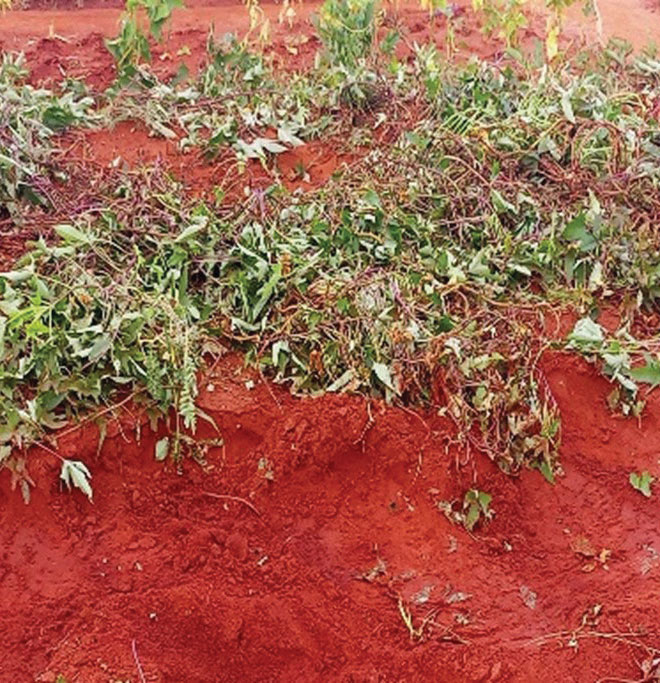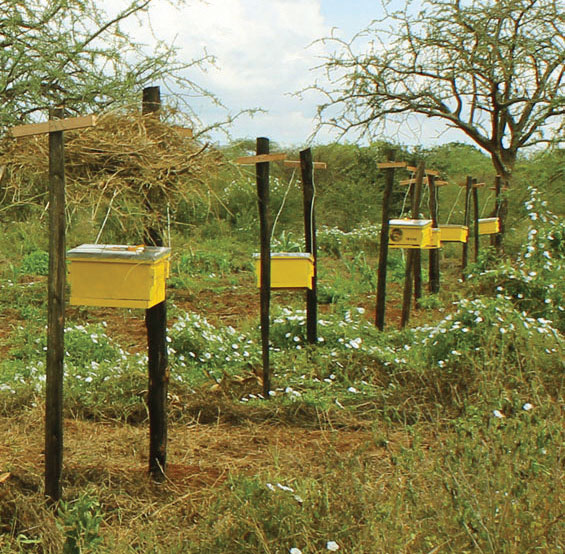Possible Solutions:
Elephants and Bees
In a region enduring an extreme ongoing drought, encounters with wildlife desperately seeking food and water are a real problem for the people living in elephant territory like Taita Taveta County. Many farmers rely exclusively on the food they grow to feed their families and to earn an income, so elephants eating their harvests and destroying plants they have worked so hard to grow is a very serious issue. And human/elephant encounters are dangerous for both: elephants can easily injure or kill a human in their quest for food, and endangered elephants can be injured or killed by people trying to defend their crops. When I heard about Mlesh’s difficulties with elephants, I remembered an interesting article I'd read about how some Kenyan farmers having similar problems are using strategically placed beehives to deter elephants from coming into their gardens. The 2016 Amusing Planet article states: “This so called ‘beehive fence’ was first deployed as a test in Kenyan farms by a charity organization called “Save the Elephants.” Farms were fenced off by nine beehives hung under small, thatched roofs. Each beehive was placed ten meters apart and were linked together by wire. Researchers found that farms protected by beehives had far less human-elephant conflict than unprotected farms. … The fences are easy to make using only locally sourced materials, and they cost a fraction compared to the cost of concrete barriers and electrified fences. Even with the hives empty of bees, elephants are wary of nearing them as the smell of the hives is enough a deterrent. The hives are connected by wires so that if an elephant tries to cross the barrier, the interconnecting wire shakes the hives releasing the bees. The resident communities also benefit from the bees, through the harvest and sale of honey. Pollination work of the bees can also increase biodiversity and even increase the yield of the crop that they protect. Researchers are not sure why elephants are scared of bees, because an elephant’s skin is too thick for bees to cause any damage. But there are areas where bees can and do sting elephants, for example, around eyes and inside of the trunk. It’s possible that elephants avoid bees to prevent such an experience.” A little more research revealed that the Save the Elephants organization mentioned in the article still exists, and promotes the use of beehive fences among Kenyan famers through The Elephants and Bees Project, which I thought might be useful to Mlesh if he decides to try putting a beehive fence in, especially since the organization is located relatively close to Garden of Hope. Their website states that “The Elephants and Bees Project is part of the Save the Elephants’ Human Elephant Coexistence Program, based in Sagalla, Kenya, next to Tsavo National Park. Our award-winning project explores the use of Beehive Fences as a natural elephant deterrent, helping protect farmers and farmland. The idea is based on our innovative research using elephants’ fear of African honeybees to help reduce crop-damage and minimize other human-elephant conflict incidences. A win-win addition to a toolbox of deterrent methods, beehive fences help create a social and economic boost to farmers through pollination services and the harvesting of ‘Elephant-Friendly Honey’.”
We wrote to Mlesh to let him know about this possible resource and he was enthusiastic: “I am happy and thankful to hear about this important approach that's reducing human-wildlife conflicts amicably. The problem is currently rampant to my community, as all the elephants have left the [Tsavo National Park] and are living in the community. The little farm produce which is left by the scorching sun is consumed by the elephants, and people are not sleeping at night because they have to keep watch to guard their crops. At our farm, we have experimented with planting chilies/hot peppers around the garden beds, but it works as a deterrent only when the elephant accidentally eats a chili with another palatable crop. “Elephants and Bees” is an exciting project and fortunately is in my VOI sub county. Please put me in touch with them, as I would like my farm to be a demonstration garden for this project. If it is a success, it will help thousands of community members who are currently spending sleepless nights like us due to the perennial problem of human-wildlife conflicts. Thank you so much once more.” Luckily, Elephants and Bees offers training very much along the lines of the GROW BIOINTENSIVE farmer-leader training programs we and our partners offer, where people can learn the techniques, and are encouraged to take them back to their communities to propagate: “… for people who wish to come to the Elephants and Bees Research Centre and fully engage with the project, enabling them to return to their own communities or to those they are working with and implementing the effective beehive fence as an elephant deterrent. We can host training visitors (from Kenya or other HEC hotspots in across Africa & Asia) from a few days up to 2 weeks to be fully submersed in how the project works. Our staff team, led by our Beehive Fence Training Officer, are experts on beehive fences and the struggles of living with elephants and will give you a thorough insight into how the E&B project works and the beehive fences as an elephant mitigation in order for you to return to your own HEC sites with the best potential to alleviate the conflict. To find out more about the beehive fence training please get in touch with us.” We're going to try to help Mlesh get in touch with the project, where hopefully, he can get the training he needs to use beehives to protect his crops, make honey, and teach others to do the same, so the elephants and humans can coexist peacefully. If you would like to make a donation to Mlesh’s project to help make this happen you can do so at https://donatenow.networkforgood.org/gardenofhope ♥ top | Newsletter Home |Table of Contents| Archive
|


 Mlesh Mlegwa, Director of our partner organization Garden of Hope CBO (a grassroots non-profit organization in Taita Taveta County, Kenya) wrote to us of the difficulty he and the small-scale farmers he trains to use GROW BIOINTENSIVE are encountering from hungry elephants foraging in their gardens:
“We resumed our normal Mbulia farmer’s field meetings on the last week of January with an analysis of the elapsed season. The season has been marred by a lot of challenges like stressed rainfall and continued living with wild animals like the elephants. These have destroyed the few crops people have managed to salvage from severe weather, and some members did not harvest anything due harsh weather and as for others, their little produce was destroyed by elephants.”
Mlesh Mlegwa, Director of our partner organization Garden of Hope CBO (a grassroots non-profit organization in Taita Taveta County, Kenya) wrote to us of the difficulty he and the small-scale farmers he trains to use GROW BIOINTENSIVE are encountering from hungry elephants foraging in their gardens:
“We resumed our normal Mbulia farmer’s field meetings on the last week of January with an analysis of the elapsed season. The season has been marred by a lot of challenges like stressed rainfall and continued living with wild animals like the elephants. These have destroyed the few crops people have managed to salvage from severe weather, and some members did not harvest anything due harsh weather and as for others, their little produce was destroyed by elephants.”

